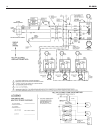
tion, heavy sooting and health hazards. Any oil-fired boiler
must have a steady draft* and an ample supply of combustion
air at all times during firing. If air supply or chimney draft* is
unreliable, CO
2
and overfire draft* will change unpredictably.
D
O NOT vent this boiler to the same chimney flue used by a
fireplace or coal or wood burning furnace or boiler.The draft*
produced by solid fueled devices varies tremendously
between high fire and low fire:
In modern, weather stripped, energy-saving buildings or older
buildings which have been modified similarly, natural infiltra-
t
ion may not supply enough air for combustion, particularly if
other fuel burning appliances, exhaust fans or draft inducers
are competing for the same air supply. Fireplaces, other solid
fuel burning appliances and exhaust fans consume great
quantities of air; if air supply is not ample, such an appliance
will create a downdraft in the oil-fired boiler flue. This can cre-
ate a hazardous condition. Flue gases can be sucked out of
t
he chimney through the vent regulator into the living space.
DO NOT operate this boiler and a solid fuel burning appliance
at the same time, unless the solid fuel burner is provided with
i
ts own outside air supply.
See Table 2, “Provisions for Combustion and Ventilation Air
Supply” for determining need and method of providing air for
combustion and ventilation.
If fly screen must be used over air supply openings, areas cal-
culated should be doubled; the screen should be inspected
and cleaned frequently to maintain free air flow.
Protect air openings against closure by snow, debris, etc.
Openings such as doors or windows, if used, must be locked
open.
XL-2000
4
TABLE 2: Provisions for Combustion and Ventilation Air Supply. See NFPA 31, latest edition for more detailed information.
Boiler Location Air Supply
2.1 Unconfined space Is there sufficient air for combus-
tion by natural infiltration (see
NOTE (1), “Test...” below)?
2.2 Unconfined space If there in NOT sufficient air for
combustion by natural infiltration
due to tight construction or other
conditions, then it REQUIRES AIR
FROM OUTDOORS. SEE
“ACTION REQUIRED” column at
right. See Notes (1) and (2) below.
2.3 Confined space If there is sufficient air for combus-
tion from within building but it
comes from outside of the
confined space, see “ACTION
REQUIRED” column at right.
See Note (1) below.
2.4 Confined space If there is NOT sufficient air for
combustion due to tight construc-
tion or other conditions it
REQUIRES AIR FROM OUT-
DOORS. SEE “ACTION
REQUIRED” column at right.
See NOTE (2) below.
Action Required
NONE
Provide air from outdoors directly through a permanent out-
side wall opening or openings with a free open area of not
less than 1 sq. in. per 4000 Btu/hr of TOTAL input of ALL fuel
burning appliances in the building. See Note (1) and (3).
The confined space shall be provided with two permanent air
openings, one near the top of the enclosure and one near the
bottom. EACH opening shall have a free air opening of not
less than 1 sq. in. per 1000 Btu/hr. of TOTAL input of ALL fuel
burning appliances within the enclosure.The two openings
shall freely communicate with the interior areas of the building
which in turn would have to have adequate infiltration of air
from outdoors. See Notes (1, 3) and Figure 3a.
(a) Air from the outdoors shall be provided to the confined
space by two permanent openings, one in or near the top
of the enclosure space and one in or near the bottom.The
openings shall communicate directly, or by means of
ducts, with outdoors or to such spaces (crawl or attic) that
freely communicate with outdoors (See figures 3b, 3c
and 3d).
(b) Where directly communicating with outdoors or by means
of vertical ducts, each opening shall have a free area of
not less than 1 sq. in. per 4,000 Btu/hr. (35 sq. in. per gal.
per hr.) of total input rating of all appliances in the enclo-
sure. If horizontal ducts are used, each opening shall have
a free area of not less than 1 sq. in. per 2,000 Btu/hr. (70
sq. in. per gal. per hr.) of total input of all appliances in the
confined space. See Figures 3b, 3c and 3d.
(1)Test for sufficient air for combustion by infiltration by running this boiler for 30 minutes under all of the following conditions and at the same time:a) all doors, win-
dows and other like openings must be closed, b) all fuel burning appliances should be FIRING, c) all exhaust fans and clothes dryers turned ON. At the above
conditions the CO
2
, smok
e and draft readings must be normal. (CO
2
betw
een 11% and 13%, smoke between ZERO and a TRACE, draft between .02”W.C. and
.04”W.C. negative pressure.)
(2)Aside from tight construction, some of the conditions that steal air for combustion from a boiler are other fuel burning appliances, exhaust fans and clothes dryers.
(3)Generally, louvers made of wood have a free open area of 20% and those made of metal have a 60% to 70% free open area.Screens also reduce the open area
of the louvers.
* Draft is negative or suction pressure

















